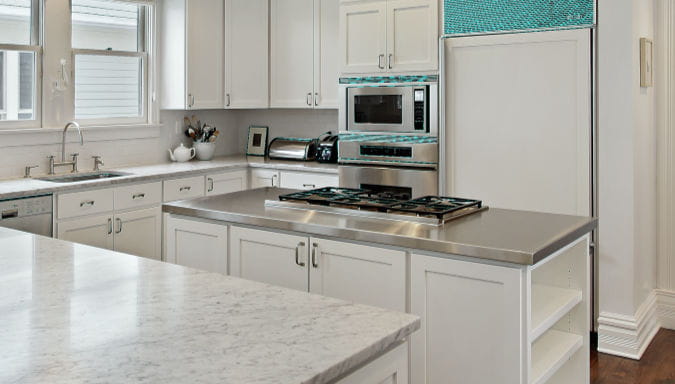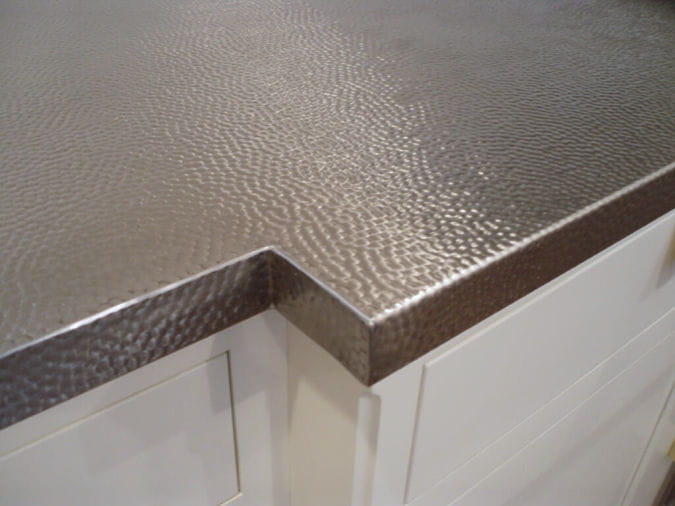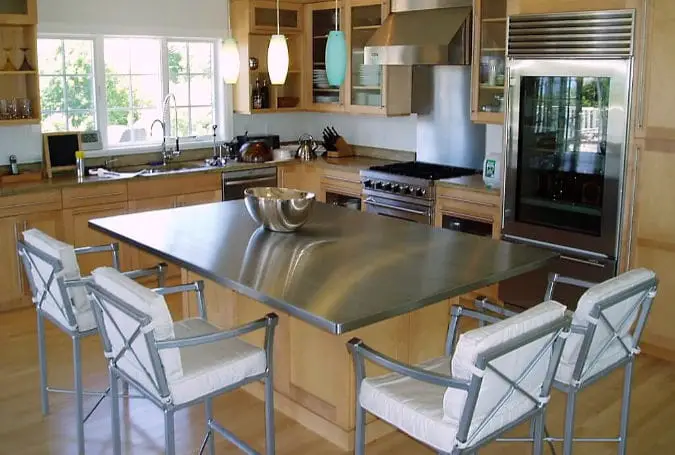Stainless Steel Countertops
Buyer's Guide
Stainless steel countertops are the obvious choice for those wanting a premium, professional-looking kitchen. After all, you can't go wrong with what the pros use, and you'll find stainless steel kitchen countertops in nearly every high-end restaurant from New York to Tokyo.
In fact, these countertops were once only found in the back-ends of restaurants. Now, however, they've made their way into mainstream kitchen design, and it's been in large part due to the “industrial look” trend that's taken home design by storm. Here you’ll learn if stainless is the right choice vs. other countertop options.

Quick Navigation
- How Stainless Countertops Are Made
- Style, Design, and Installation
- Stainless Steel Countertops: Pros & Cons
- Cleaning, Maintenance, and Repairs
- Cost of Stainless Steel Countertops
- Are Stainless Countertops For You?
How Stainless Steel Countertops Are Made
Stainless steel countertops are custom-made for your kitchen at sheet metal fabrication shops. The process begins with all raw materials — mostly sheet stock and some tubing product (if needed for legs).
At the shop, workers refer to “breakdown sheets” of your countertop designs (think blueprints) to complete all of the cuts, holes, and bends that are necessary.
Generally, one large sheet is cut down to size using a large, guillotine-like blade, and then the appropriate holes and cuts are made to account for the sink, faucets, backsplash, and turns in your counter space.
A large machine also bends the sheet in the appropriate spaces to create finished edges where necessary. Finally, any required welding is finished up at the shop before the finished products are shipped to your home.
Protective vinyl covers will protect the shine and polish during shipment, and sparse additional assembly will take place on-site to finish the installation.
All types of metal countertops are fabricated in more-or-less the same manner.
Buying prefab stainless steel countertops is also an option. These are more like tables of different sizes that can increase your overall kitchen countertop area.
Style, Design, and Installation Options
 Image Source: Brooks Custom
Image Source: Brooks CustomFinish. Numerous finishes and polishes are available for stainless steel. These include brushed, mirror polish, hammered, antique matte, and satin polish. A brushed finish is a favorite because it doesn’t show fingerprints as well as the others.
Many custom finishes and surface designs are available. However, the specialty designs are used primarily on backsplashes and rarely used on countertops. Most commonly countertop surfaces get a brushed or matte finish to help diminish fingerprints.
Edge Profile. Most homeowners prefer the square edge style for stainless steel countertops, but beveled, unwrapped, and bullnose (rounded) edge styles are also popular. There’s also the marine edge (much-favored by restaurants), which keeps liquids from pouring onto your shoes as you wash, slice, and prep.
Gauge. Stainless steel comes in various gauges typically ranging from 14 to 20. The lower the gauge, the thicker, stronger, quieter, and more expensive the steel. Most restaurants, for example, have 14-gauge steel.
In residential applications, using 16 or 18-gauge steel is perfectly fine. No real need for the extra expense of 14 or 12 gauge. But beware if you venture into the 20 or (heaven forbid) 22-gauge range. This is nearing quite flimsy steel that will scratch and dent almost immediately.
Backsplashes. Typically, stainless steel is used as a countertop and sink material, and other materials such as tile are used on the backsplash. It is possible, however, to design your counters with a connected countertop and stainless steel backsplash. The sheet will simply be bent up for the backsplash (or seamlessly welded). And in fact, this is an optimal setup for easy cleaning.
Seams. You shouldn’t have noticeable seams in your metal countertops. Depending on the shape of your design, it’s possible that two sheets will need to be combined — usually using a butt seam. But if this is required, all signs of the connection will be brushed out in fabrication, and you will be left with a flawlessly uniform surface and no seams.
Sinks. A hole for your sink must be cut out of your metal countertop at the fab shop. However, most homeowners opt to also have a stainless steel sink. In this case, the sink would be fit into the hole and welded to the countertop for a flawless, seamless finish.
Undercoating. Certain areas of your countertops (near the sink, for example) may benefit from pads or undercoating that can help deaden sound.
Stainless Steel Countertops: Pros & Cons
Here’s why many people love these countertops.
The Pros
Easy Installation
Some countertops require days of installation. Concrete must be poured, and granite usually must be sealed. Tile must be measured, cut, laid, grouted, and sealed. Wood must be cut, sanded, and sealed, and the list goes on.
For stainless steel, however, once the fabrication shop has your designs, they do the cutting and assembly there, meaning there’s little to do once the finished countertops arrive at your home.
Hygiene
Stainless steel is nonporous, which means it won’t absorb food juices, and it’s naturally antibacterial and antimicrobial. All of this means that it’s ideal for protecting you and your family from food-borne illnesses.
Resistance to Burns and Rust
Naturally non-corrosive — due in large part to the high percentage of nickel it has — stainless steel will never rust. It’s also burn-resistant, so feel free to set your piping hot pot or pan directly on the counter.
Elegant Modern Design
With its sheen and simplicity, stainless steel is both modern and timeless. It can blend with nearly any décor and always looks sleek. The reflective qualities of a stainless steel finish will also pick up on your design hues and mimic the temperature in the room. It can even help your kitchen space appear bigger than it actually is.
Integrated Sink
Sinks can be seamlessly integrated with the countertop surface for a smooth and elegant look and easy cleaning. Drain boards can be fabricated next to the sink as well.
Recyclable
Unlike many other countertop materials, stainless steel is 100 percent recyclable, so choosing it is definitely an earth-friendly decision.
Drawbacks of Stainless Steel Countertops
There are always cons, aren’t there?
Excessive Noise
One thing to know about stainless steel countertops is that they’re loud. If you’ve ever worked in a restaurant kitchen, you probably remember their rumble and roar.
Ladles, pans, cutting boards, and any other large item you set on your stainless steel surface will make, at the least a clang, and at the most a rumble. If excess noise is something that especially bugs you, these countertops could very well drive you nuts.
On the other hand, some people don’t have a problem with the clatter and clash.
And if you opt for a super-lower steel gauge (14 or 12 - more expensive), you’ll experience less of a noise problem. Or installing the steel over an underlayment like plywood, or applying an undercoat, or attaching padding on the underneath side will greatly reduce the noise.
Susceptibility to Scratching and Denting
For the most part, stainless steel is super durable and resistant to burns, rust, and breakage. But that initially perfect finish won’t last forever as scratching and denting (especially from large cookware) is eventually likely.
Damage is especially likely if you opt for a flimsy gauge. Counterintuitively, you want a lower gauge (14 or 16, ideally), which will be thicker and more resistant to scratching and denting. It will also help cut down on noise. Watch out for 20 and 22-gauge; it’s thin, loud, and more susceptible to damage.
Susceptibility to Fingerprints
You may not think that fingerprints and smudges are a big deal, but if you love a spotless kitchen, they can drive you up a wall. Take heart, however, if you still want stainless countertops.
All you need to do is opt for the brushed finish. Smudges will still happen, but the soft, smooth appearance of the finish will easily hide them.
Excess Heat Transferring
Like any metal would, stainless steel will heat up quickly and powerfully when you set a hot pot or pan on it. Fortunately, this heat won’t burn the steel, and the heat will not transfer along the length of your countertop.
“Cold” Clinical Appearance
As the heart of the home, the kitchen is a place that most homeowners want to be warm and inviting. Stainless steel, however, is noteworthy for its cold, industrial look.
If you’re not sure you want this look, one option is to use stainless steel for only part of your countertops. For example, many homeowners choose it for an island while using another, more “homey” material for the rest of their counters.
Or incorporate other warmer elements like wood floors into your overall kitchen design.
High Expense
Stainless steel countertops can be just as expensive as marble countertops. When your countertops are being manufactured, the raw steel is sold by the pound.
Also remember that stainless steel is measured in gauges, and the lower the gauge, the thicker, stronger, and more expensive the steel.
However, options for inexpensive stainless installations do exist. See the “Cost” section below.
Cleaning, Maintenance, and Repairs
 Image Source: Brooks Custom
Image Source: Brooks CustomCleaning stainless steel is relatively easy. Just use warm water and a soapy sponge, or when required, scrub the surface with white vinegar and baking soda.
In addition to being simple to wipe off, most stainless steel countertops are connected in one piece with the sink, meaning there’s no sink lip, and you can wipe debris and liquid directly in.
Other Cleaning and Maintenance Tips
- Despite its name, stainless steel can stain (or rather, blemish), and ironically, most marks occur from using the wrong cleaning tools and products. Avoid abrasive cleansers, steel wool, abrasive scrubbing pads, oven cleaners, products containing chloride, and bleach.
- It’s important not to clean your stainless steel until it’s cool to the touch.
- To prevent water spots, always rinse and towel dry surfaces after cleaning. A simple cotton cloth works great.
- When cleaning, always wipe with the grain.
- To protect and maintain the shine use a quality stainless steel cleaner / polish.
Repairs
Scratches and dents can occur. For small surface scratches, you may be able to buff them out carefully by using a pad or sponge with mild abrasion (180–grit). However, beware — test the abrasive pad on a non-visible part of the steel to make sure you won’t cause further damage. As you buff, work with the grain of the stainless steel to try to blend the mark in.
For large dents, it is possible to use the same process used to remove auto dents (essentially pushing the steel flat), but often, this isn’t very effective. And if that’s the case, the only way to resolve the issue is to have the part replaced.
Cost of Stainless Steel Countertops
The cost of stainless steel countertops has a much wider range than most types of countertops.
- Expect to pay $80 - $135 /sq. ft. on average for professional installation
- However, prices can range from $40 - $250/sq. Ft.
The primary price factors are the gauge of the steel and who does the installation (a pro or DIY).
Also added seams, holes for custom sinks and faucets, backsplashes, specialty edge profiles, and specialty finishes will bring the price up.
DIY stainless steel countertop installation will save you a bundle and it isn’t too difficult of a project. You’ll need to work with a fabricator to actually construct the countertops, but the measuring, prep, and installation are up to you.
A budget option is to get the stainless steel look with adhesive vinyl sheeting that can be applied to an existing laminate surface for instance.
To estimate the cost of your stainless steel project, you’ll need to take some measurements and make some style choices.
Measure your countertops by grabbing a pencil and paper. Now, begin breaking down your countertop into rectangular or square sections. Start with as big of an area as you can and record the depth and length in inches on your paper.
As you get to smaller areas, record those too — also in rectangular or square sections. Any triangular or rounded areas should be counted as a square or rectangle even if they don’t fill the whole space. Include areas designated for your cooktop, sink, and backsplash.
Now, with each section, multiply the depth by the length to get the square inch area of that section. Add all of the section areas up, and divide this number by 144. Round up to the nearest whole number. The result will be your countertop space in square feet.
Next, use a cost calculator to get your cost estimate. Simply input stainless steel countertops as your material, and adjust the sliders to match your chosen installation preferences.
Are Stainless Countertops For You?
If you’re in the midst of a kitchen remodel or just need a change, deciding on a new countertop material is always an arduous experience. As you can see, there are many things to love about stainless steel: it’s super hygienic, easy to clean, doesn’t rust or burn.
And certainly, if you’re a serious cook, the answer is clear: stainless steel is hands down the go-to material for professionals.
If you’re simply looking for something new and different for your residential kitchen, however, make sure you know what you’re getting into with stainless steel.
First, it’s definitely louder than your average tile or marble top. It’s also prone to dents and scratches, and it can be just as costly as the most expensive marble.
Making your final decision on countertops will be tricky. But with the resources above and the customary days and weeks of reflecting and mulling that comes with any home improvement choice, you’ll be sure to make the right decision on whether stainless steel countertops are right for you.


